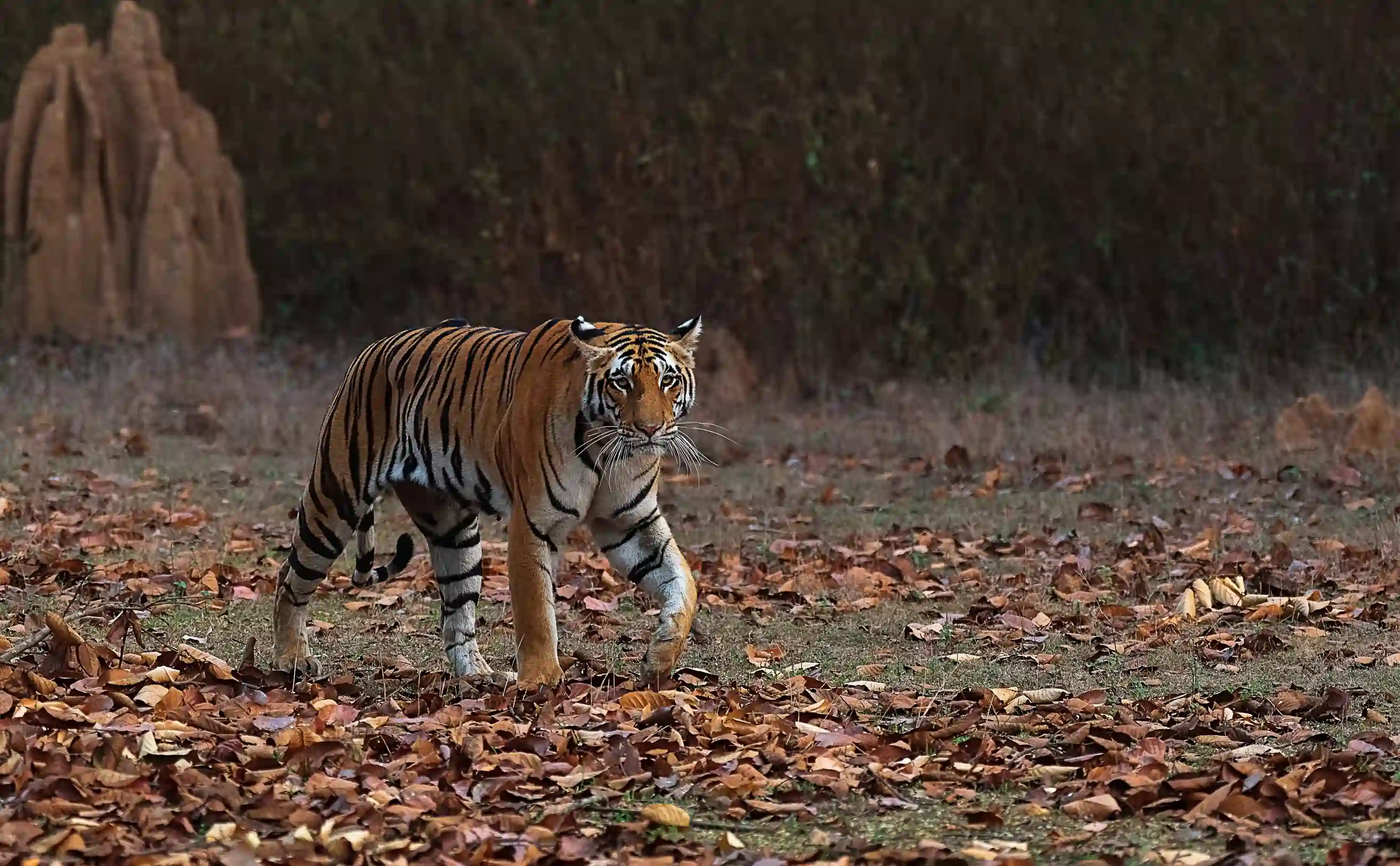TIGER SAFARI IN KANHA National Park
An adrenaline pumping Tiger Safari in Kanha can transport you to a whole new world of adventure. Spotting the Royal Bengal Tiger in the wild is an experience parallel to none. The regal strides, the gracious demeanour, the royal stripes blending in the wilderness; make it an exclusive experience to cherish for a life time. India with 54 Tiger reserves, is the best place to see tigers in the wild. India is home to more than 2/3rd,, which makes up to almost 75% of the total tiger population of the world.
Top 5 things to do in Kanha National Park
Kanha National Park offers a range of activities like Jeep Safaris, Nature trails, cycling tours, visit to Kanha museum and tribal museum. It has also beautiful villages which are wonderful to explore and soak in the culture. It gives the tourist many options to choose from.
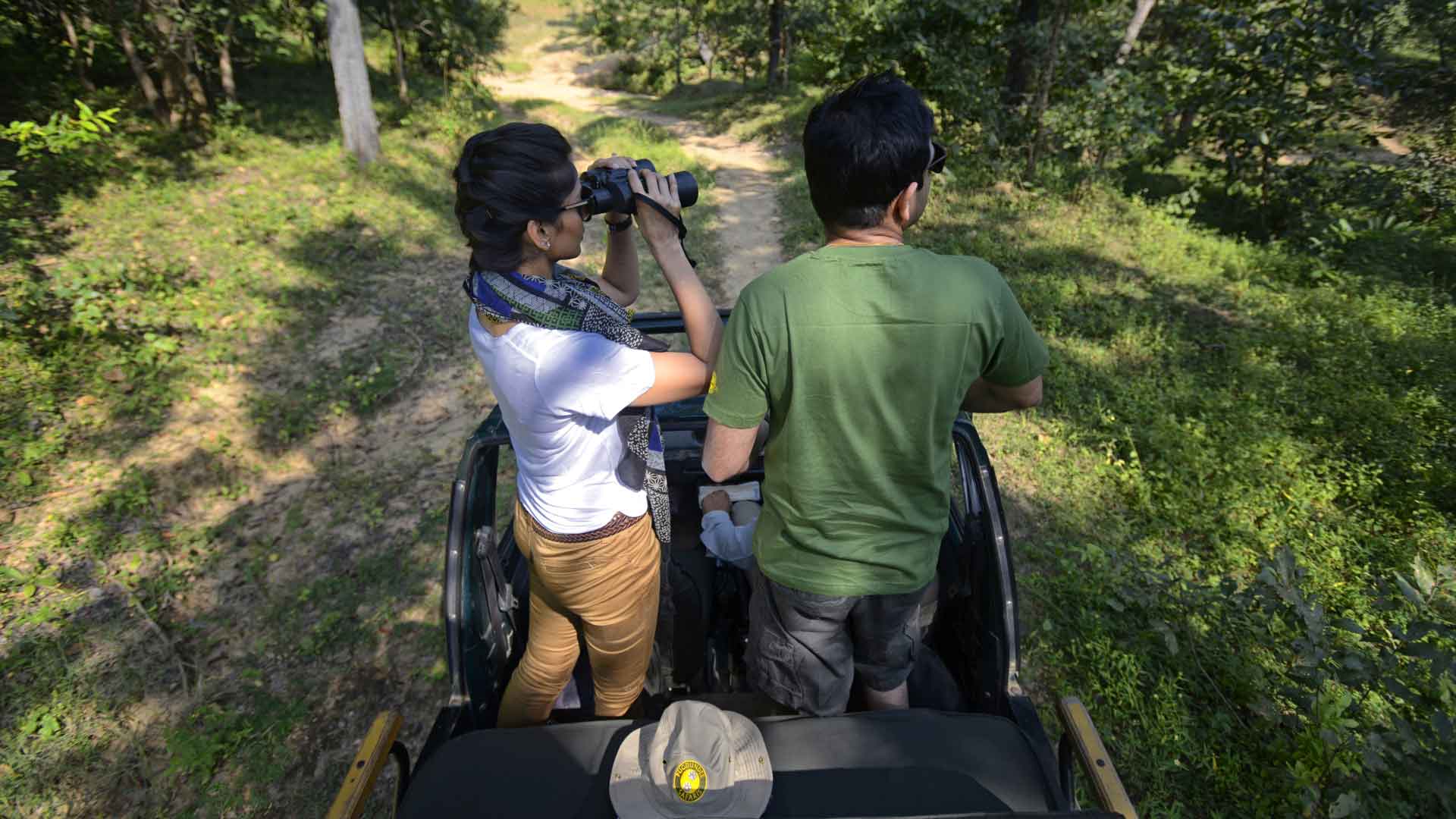
1. Jeep Safaris In Kanha National Park
An adrenaline pumping tiger safari in Kanha can transport you to a whole new world of adventure. Jeep safari is an exclusive experience of sighting Kanha’s teeming wildlife and flourishing natural habitat.
Navigate through the core or buffer forests of Kanha in an open top jeep safari, which ride off at the crack of the dawn, or venture out in the afternoons as the sun beats a retreat into the transiting evening sky.
Accompanied by experienced naturalists in these open jeeps, the safari experience offers a getaway to new vistas in exploration and adventure. Places of interest inside the park include Shravan Tal, Kanha Meadows, Lapsi Kabar, which is a gravestone and the Interpretation Centre.
Kanha tiger reserve is also the forest that inspired the popular novel by Rudyard Kipling ‘The Jungle Book’ about Mowgli, a boy who was raised by wolves. It is also famously known as ‘Kipling’s Country’. You would still find Baloo, the sloth bear nosing around for termites, Bagheera, the leopard hunting silently; and the langurs swinging from tree to tree. The mighty Sher Khan still roams free in these magical forests, that comprise one of the last strongholds of this most magnificent of cats, the Royal Bengal Tiger.
2. Mystical Nature Trails And Serene Cycling Trails
Allow the exquisite flora and fauna of Kanha bewitch you on exclusive nature and birding trails, and cycling expeditions.
Nature Walks: Nature trails can enhance your five senses and rev up your inner well-being. A truly therapeutic experience, a serene jungle walk is for those who wish to explore nature and wildlife from close quarters, while being on foot. A guided walk through the lush landscape may throw up unique surprises, of birds and bird sounds you never knew off or sighting the most incredible beings that home in the tranquil wild.
Cycling Trails: Explore the forests and stumble upon wildlife on an exhilaratingly, unique bicycle ride. Become one with yourself and the mysterious forests, while on a cycling expedition, through the meadows and uneven terrain. During these excursions, you can also spend some unique moments exploring a few small lakes, or immerse in moments of solitude by the Banjaar River, with a picnic basket for company.
Khatia Walking Trail by the Forest Department – The Khatia walking trail takes place in the Khatia buffer zone of the park, for a duration of approximately two to three hours. A permit needs to be obtained from the forest department for this walk. Accompanied by a local guide from the forest department, this walk can lead to chance encounters with spotted deer, sambhar deer and some other wildlife. Soak in the surreal sights of myriad flora and fauna. Enjoy the perks of bird watching, butterflies flitting from bush to bush or even sighting some unique reptiles.
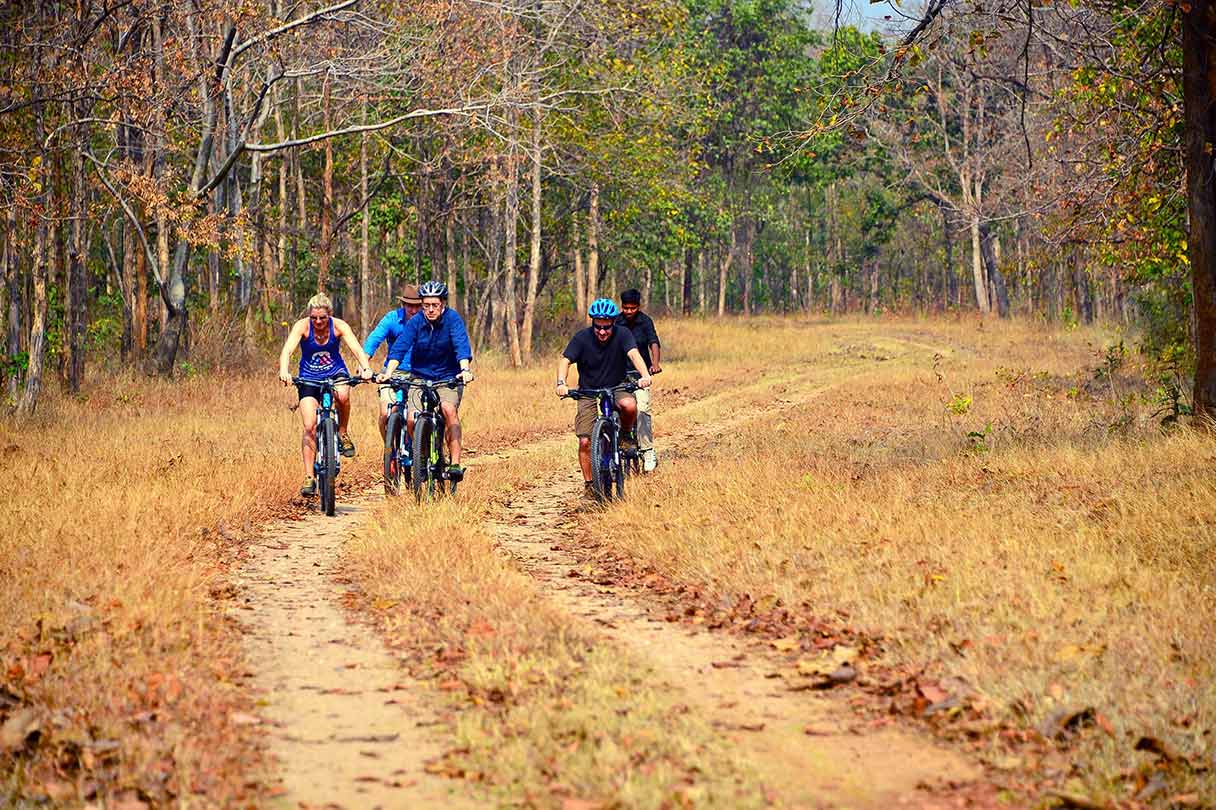
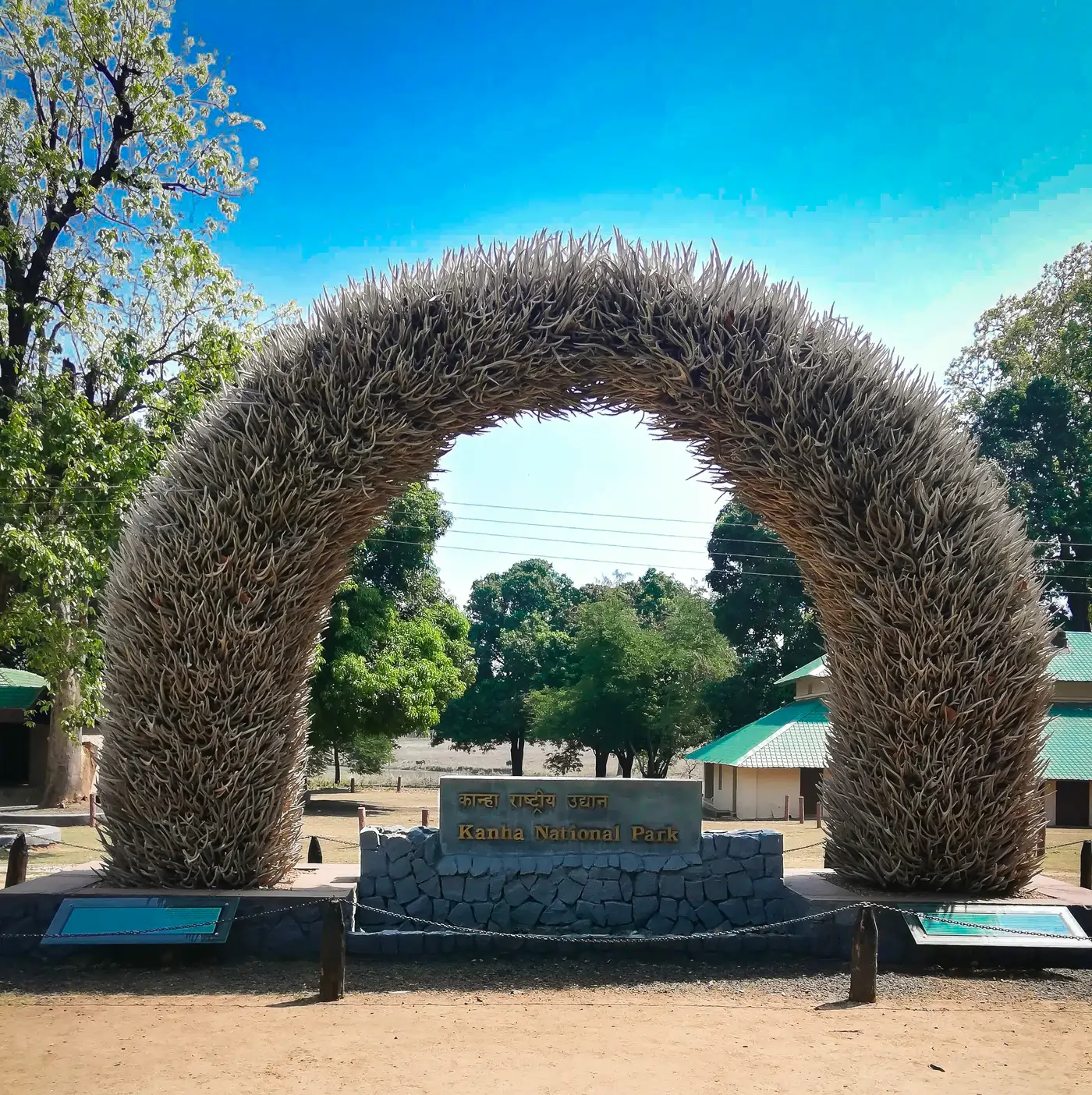
3. Historical Journey To The Kanha Museum
Kanha museum is located inside the Kanha National Park and is set in a colonial building housing a few halls. It showcases the splendour and history of the park with fascinating exhibits of various wildlife.
The Kanha museum, managed impeccably by the Forest Department, is also a befitting example of environmentally sustainable initiative that preserves the local art and culture. Guests having valid tickets to the Kanha core zone can visit the museum during the breakfast break of their safari.
4. The Vibrant Tribal Bazaars
A tribal market or haat (as it is locally called) is a perfect way to soak in the local flavours. Bustling with activity and bursting with a riot of colours, these bazars showcase a fascinating array of products.
These may include local artefacts, pottery, tribal jewellery, fresh organic greens or the catch of the day. Some of the tribal bazaars happen at Mocha, Kumadehi and Sarekha.
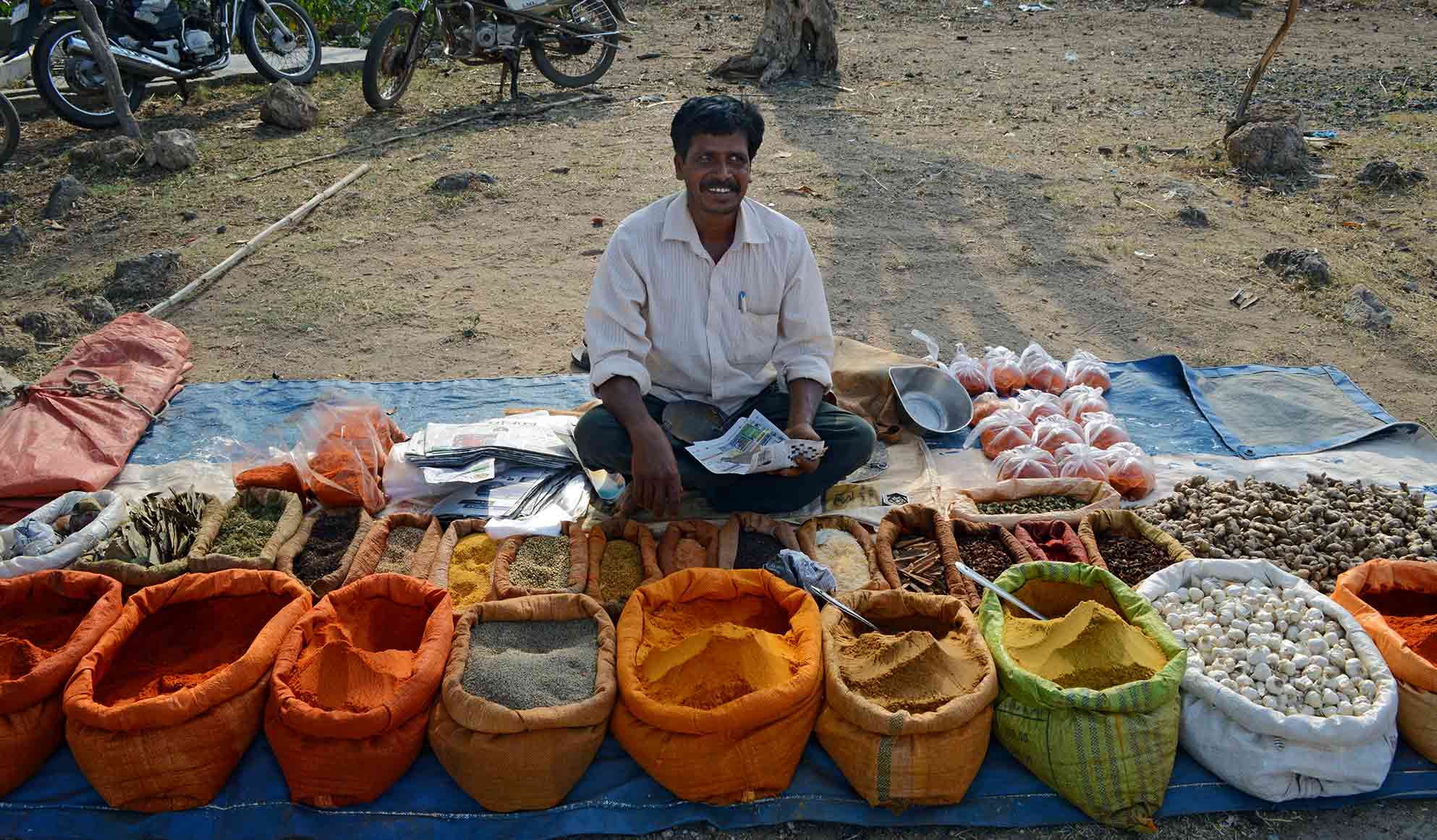
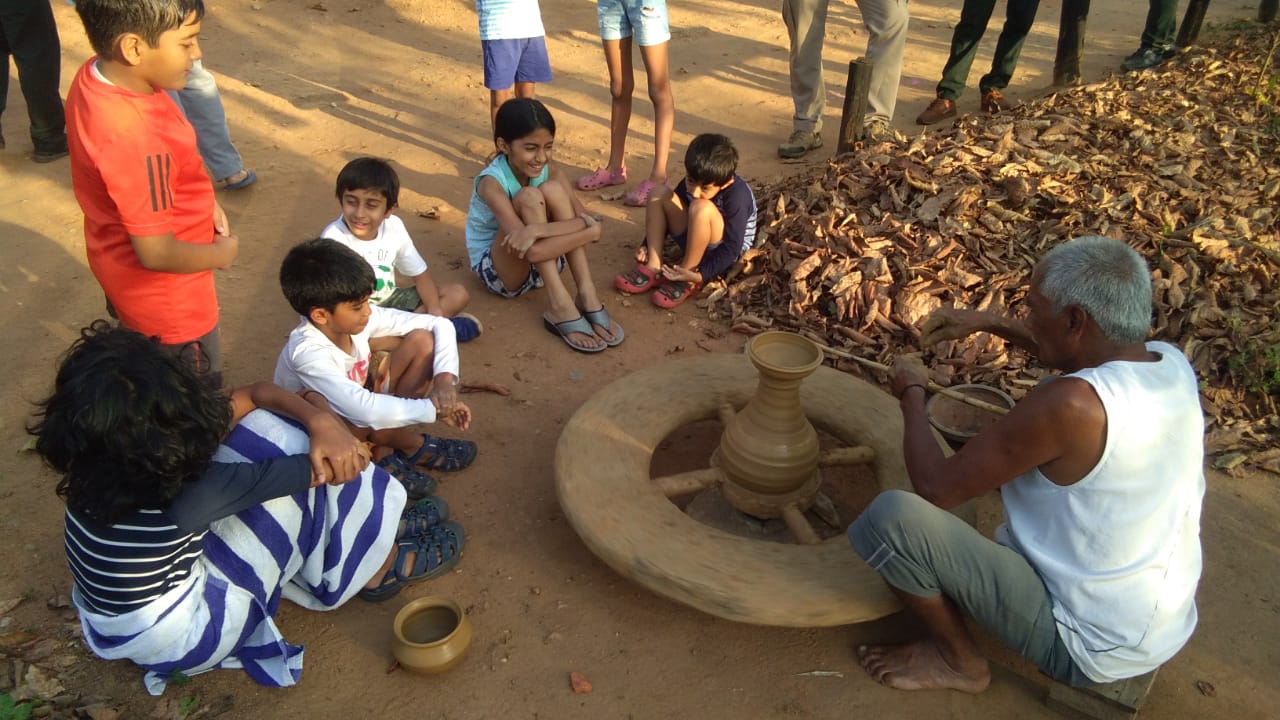
5. A Visit To The Picturesque Villages
A visit to the adjoining Gond tribal villages can be a fascinating experience. The mud settlements are adorned with tribal paintings and are every photographer’s delight. You can experience the rustic flavours of the countryside life. A chat with the locals can give you deep insights into their lives and livelihood. Enjoy a steaming hot cuppa while in conversation or, you may get lucky and be offered a local meal by the friendly tribals. If you wish to hone your artistic and crafty skills, there are a few pottery and bamboo craft villages. You can also take painting lessons from Gond painters. Try your hand at a new skill set with the local artisans, nurture your inner child, and take home tangible memories.
Looking to book a tiger safari in Kanha and want the best experience of your life? Talk to our wildlife experts now.
Questions before going for a Tiger Safari in Kanha
-
Q. Which gate is best for tiger sighting in Kanha?
Kanha National Park has several entry gates but Khatia gate is widely regarded as the best gate for tiger sighting in Kanha. Khatia zone is popular as its gives access to all 4 zones of Kanha namely Kisli, Kanha, Mukki and Sarhi. Mukki gate is also regarded as a good gate to use for entry.
-
Q. Is Kanha Tiger Reserve worth visiting?
Kanha Tiger Reserve located in Madhya Pradesh is regarded as one of the best wildlife destinations in India. A tiger safari in Kanha is one of the most searched items on Google in this catgeory. If you are someone who takes keen interest in wildlife and conservation, then Kanha wildlife safari must be on your bucket list. Combine it with nearby options like Bandhavgarh National Park and Pench National Park for a holistic experience.
-
Q. What are the chances of seeing a tiger in Kanha National Park?
Chances of spotting a tiger depends upon various factors such as season, safari zone, safari timings, naturalist and driver expertise and luck. However, most of the tiger sightings in Kanha can be recorded between the months of October and June. It also depends upon the safari zones you are visiting. However, to increase your chances one should book tickets for core zones well in advance, opt for multiple safari zones and above all be patient.
-
Q. Which zone is best for tiger in Kanha?
Kanha National Park is divided into different safari zones but the most preferred zones for tiger sighting are Kanha and Mukki zones.
ABOUT KANHA NATIONAL PARK
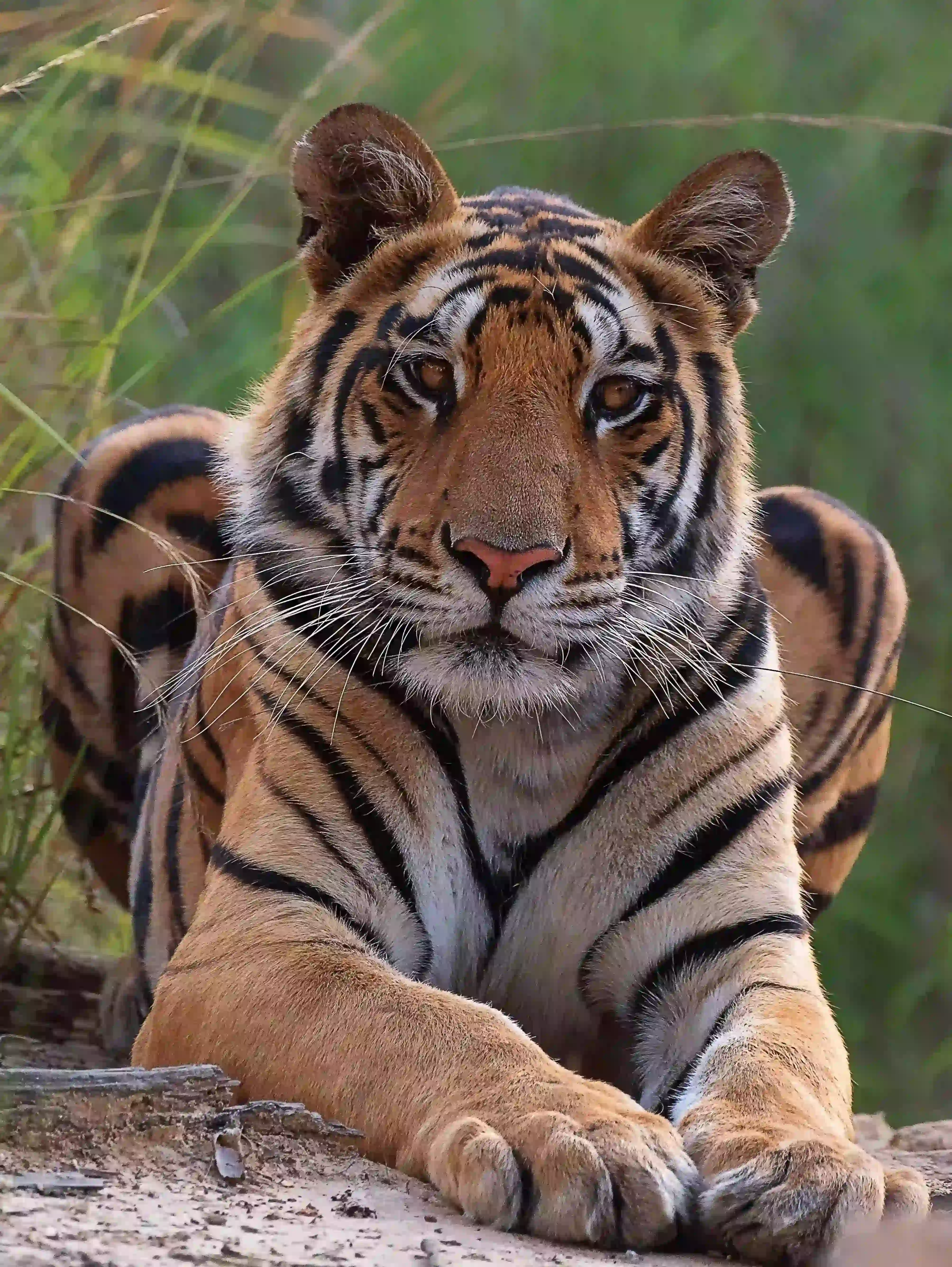
Located in Central Indian Highlands, in Maikal range of Satpura Mountains, Kanha National Park is one of the largest parks in Madhya Pradesh. It covers 2033.23 sq. km of area in total, making it an ideal tiger reserve. It also has Banjaar and Hallon valleys, making it amongst the best places to see tigers in the wild.
Project Tiger: Among the first Tiger Reserves to work for Project Tiger in Madhya Pradesh, Kanha was established as a sanctuary in 1933, declared as National Park in 1955 and eventually in 1973, it was made a Tiger Reserve. It is commonly believed that Kanha got its name from the texture of the soil found there, which is locally called Kanhar.
The Tribes: In the 19th century the reserve was originally a part of the Gondwanas i.e. the land of the Gonds. The land of Kanha was occupied by the Gonds and the Baigas, the two major tribes of Central India who still live around the Kanha National Park.
Conservation Achievements: The lush Sal and Bamboo forests of both Kanha and Pench are believed to have provided inspiration to Sir Rudyard Kipling for his famous narrative, “The Jungle Book”. Yet, Kanha’s greatest achievement, has been the preservation of Hard Ground Swamp Deer or Barasingha, from near extinction.
Kanha’s undulating landscape is dotted with dense groves of vegetation, hillocks and open meadows. Of all these habitats, it is Kanha’s meadows that are its lifeline, as they sustain large numbers of Chital, Sambar, Barasingha and Gaur. These in turn support populations of predators and co-predators like Tigers, Leopards, Wild Dogs, Jungle Cats and Foxes.
The park is primarily a moist sal and moist mixed deciduous forest where Bamboo, Tendu, Sal, Jamun, Arjun and Lendia, Sindoor tree or vermillion Tree flourish. Home to over 1,000 species of flowering plants and about 381 species of birds, Kanha’s flourishing habitat and natural beauty makes it one of the prime wildlife destinations in the world. The natural landscape and highland beauty of Kanha has been appreciated worldwide making it one of the prime wildlife destinations.
Accommodation in Kanha National Park
Accommodation
Kanha Earth Lodge, by Pugdundee Safaris is a serene sanctuary where dew drops unfurl in the early morning mist, birds flint from one branch to another; while you sip on your morning cuppa, and lord over tiger country.
Tucked away in a small tribal hamlet bordering Kanha’s buffer zone, Kanha Earth Lodge is built in less than 5% of the 16 acres of natural forest that surrounds it. The lodge and its furniture is constructed and designed using local waste wood and recycled wood; a true reflection of impeccable standards in green architecture. We offer twelve, luxury bungalows with spacious verandas that promise unhindered, stunning views.
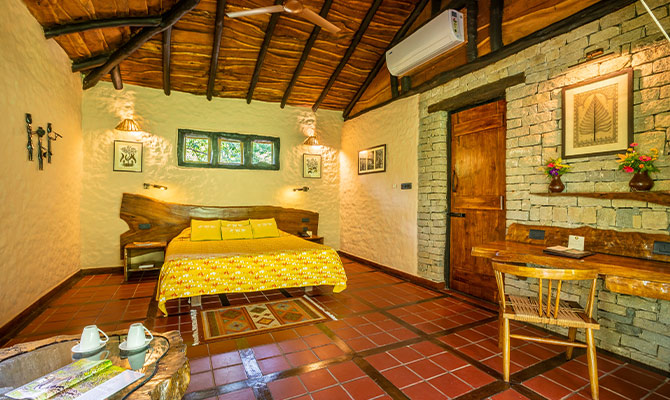
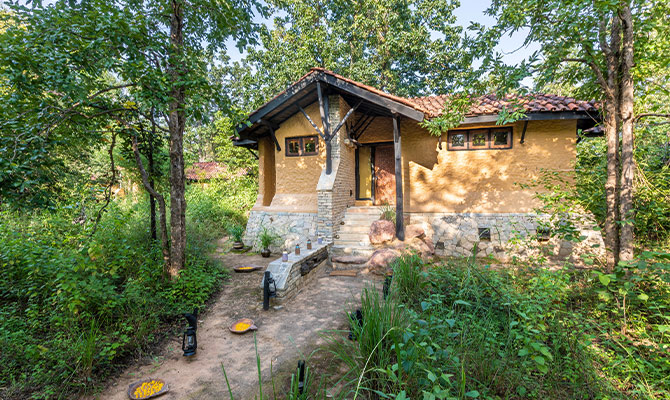
Earthy Elegance
Inspired by traditional Gond architecture, the cottages have been meticulously designed using locally available materials such as mud plaster, stone, terracotta tiles, rough-hewn timber beams. The furniture has been delicately crafted using waste and recycled wood, thereby blending seamlessly with the natural forest setting.
Swimming Pool
An oasis of relaxation, our Infinity pool is set between Mahua trees of a fringe forests. Let the stress melt away, as you unwind under the alluring, blue skies, dotted with candy floss clouds, forming a canopy over the verdant forest cover.
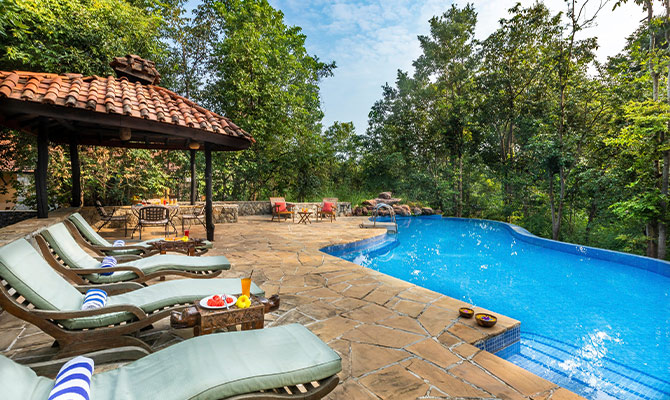
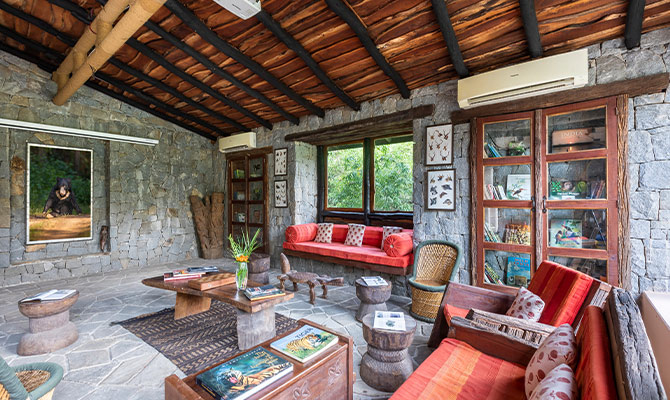
Leisurely Lounge and Reading Room
Our spacious lounge overlooking the forests, is adorned with local artefacts. This tastefully done up space with furniture designed using recycled wood and inspired by the Gond tribal culture, is a cosy nook for our weary guests.
The library or reading room stocks a wealth of literature on the biodiversity of Central India and Kanha. Equipped with a presentation screen to host special wildlife documentaries, you can spend a few relaxed evening here. Watch some well-known documentaries, or intriguing presentations by our naturalists; while the staff serves you the freshly plated hors d’oeuvres and cocktails.
Dining
Our multi-cuisine dining hall serves and curates an array of regional, Indian and continental flavours, rustled up by our expert chefs. Our dishes are made from locally sourced, fresh food produce. Tantalise your taste buds with the unique flavours of Tikkar Roti (flat bread oven roasted in camel foot leaves), Lamb Booti curry, Chakri, Basil and Beetroot ice cream and an exclusive variety of other dishes.
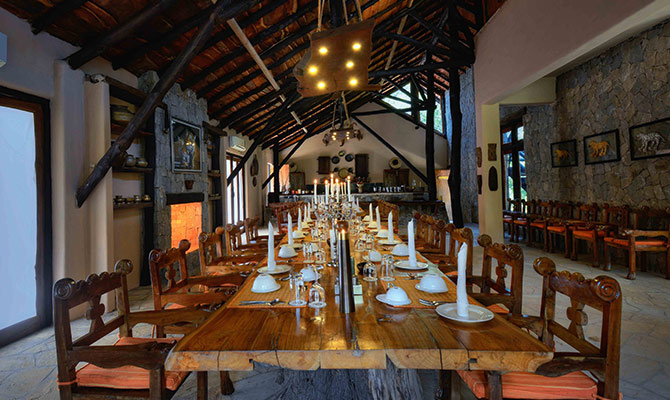
How to reach Kanha National Park
One can reach Kanha national Park either by air or train. Nagpur, Jabalpur and Raipur are the most convenient airports for people flying from Mumbai, Delhi and Kolkata respectively. Jabalpur & Gondia are the nearest railway station. It is well-connected by road with Jabalpur 170 Km, Nagpur 270 Km and Raipur 219 Km.
- Though Nagpur is an international airport and has well connected flights worldwide, Jabalpur serves as a better option for people flying down from Delhi. Nagpur is a good option for people boarding flight from Mumbai & Bangalore while Raipur is a convenient option for people boarding flight from Kolkata. Many leading airlines offer daily flights from Delhi and Mumbai to Jabalpur, Nagpur and Raipur.
- Jabalpur is the nearest airport to Kanha at a distance of 170 km from Kanha and travelling time is 3.5 hours. Second best option is Raipur airport. Distance to be covered by road from Raipur to Kanha is 225 km and travelling time is 4.5 hours. Another way is to take a flight till Nagpur. Distance to be covered by road from Nagpur to Kanha is 270 km and travelling time is 5.5 hours.
- Jabalpur is the nearest and the most convenient railway station to head to visit Kanha. Distance to be covered by road from Jabalpur railway station to Kanha is 170 km and travelling time is 3.5 hours.Gondia is another rail head from where Kanha is accessible.
- There are 2-3 trains from Delhi to Gondia, but it takes around 17 to 18 hours to reach Gondia by train.
- Distance to be covered by road from Gondia to Kanha is 120 km and travelling time is 3 hours. M.P. Sampark Kranti is the most suitable train to reach Jabalpur from Delhi. Nizamudin Jabalpur Super Express is an alternative. Details could be checked and bookings can be done on www.irctc.co.in and www.indianrail.gov.in.
- Kanha National Park is well-connected by road with Jabalpur 170 Km, Khajuraho 445 Km, Nagpur 270 Km and Raipur 219 Km. NH12 from Jabalpur to Mandla will take you to Kisli gate. Mukki gate is accessible from Nagpur via Gondia, Balaghat and Baihar. Bus and cab services are available.
Zones in Kanha National Park
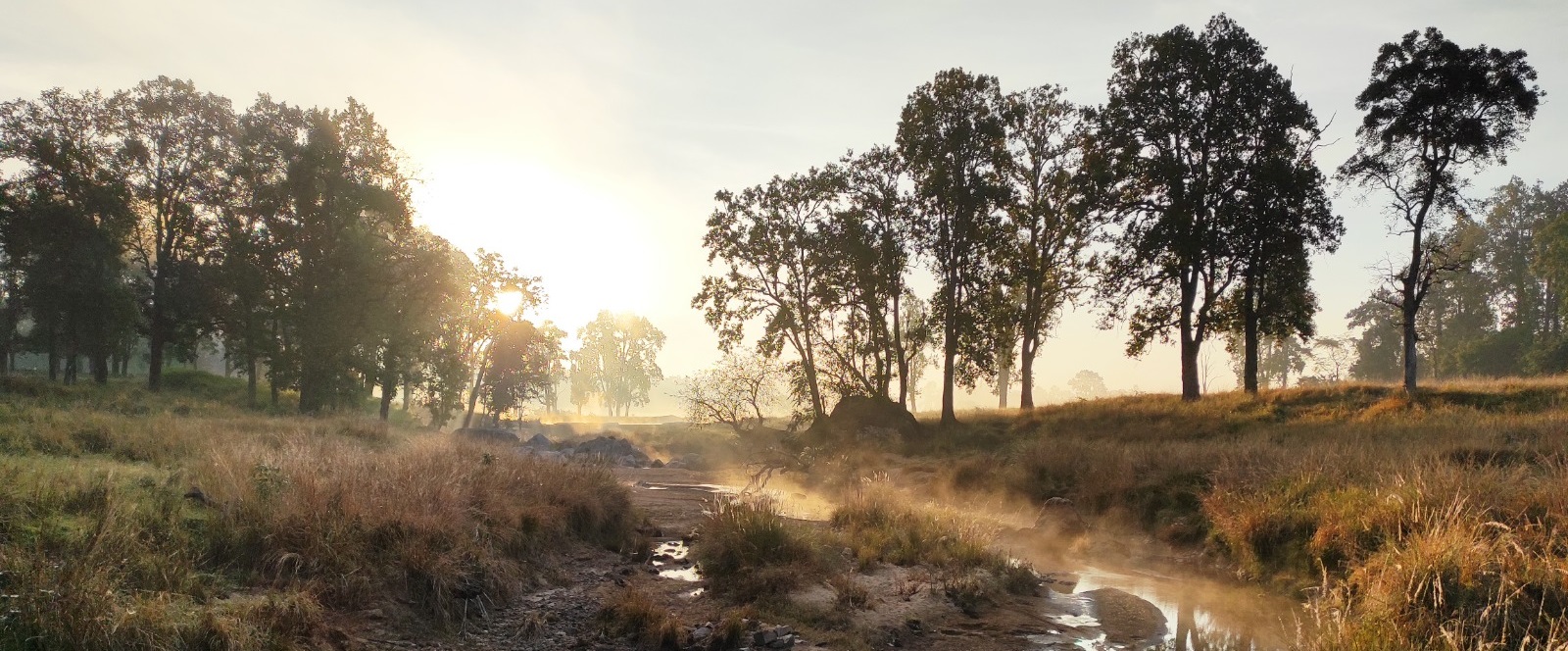
Kanha National Park is one of the most visited forest reserves in India. Most tourists visiting Kanha go for jungle safaris. The forests are divided into two major zones. The park has 4 core zones which are Kanha, Mukki, Kisli & Sarhi. It has 4 buffer zones which are, Khatia, Khapa. Phen and Sijora.
Core Zone And Buffer Zone:Core zone is the central part of the tiger reserve and it shares its boundary with the buffer zone. Core zone is basically an important area where the conservation of wildlife and natural resources is strictly prioritised by the forest department. Buffer Zone is the area that surrounds or adjoins the core areas where nature is conserved alongside compatible human uses of the land or water.
The Core Zones of Kanha are: Kanha, Sarahi, Mukki and Kisli.
The Buffer Zones of Kanha are: Khatia, Sijhora, Phen and Khapa.
In Kanha the four major safari zones are declared as the core zones. Kanha buffer zones are accessible from different entrance gates. Currently there are three entrance gates to access the national park: Khatia gate, Mukki gate and Sarahi gate. All these core zones are very popular among tourists.
KANHA TIGER RESERVE CORE SAFARI ZONES:-
| Core Zones | Entrance Gates(Full Safari) | Entrance Gate(Single Seat Safari) |
| Kanha Zone | Khatia / Mukki / Sarhi Gate | Khatia Gate |
| Mukki Zone | Khatia / Mukki Gate | Mukki Gate |
| Kisli Zone | Khatia / Mukki / Sarhi Gate | Khatia Gate |
| Sarhi Zone | Khatia / Sarhi Gate | Sarhi Gate |
The buffer zones can also be accessed as follows:
Kanha buffer zones are accessible from different entrance gates. At present three safari entrance gates are existing i.e. Khatia gate, Mukki gate and Sarhi gate.
KANHA TIGER RESERVE BUFFER ZONES:-
| Khatia Zone | From Khatia Entrance Gate |
| Khapa Zone | From Mukki Entrance Gate |
| Phen Zone(Sanctuary) | Separate gate, ideal for Mukki gate resorts |
| Sijora Zone | From Sarhi Entrance Gate |
Experience A Mix of Different Tiger Reserve Zones: All the popular tiger reserves have many zones open for tourists. Park tickets are available zone wise. It is best to do a mix of different zones to experience the entire park. Some zones in the same park tend to have a different habitat, resulting in diversity of flora & fauna. Tiger sightings also tends to move around from one zone to another, depending on a tigress with cubs, water and food availability, etc. Many parks also offer zones in both core and buffer forest of the tiger reserve.
Tiger Safari in Kanha:
Book an unforgettable experience
Contact Our Safari Specialist
How to Book Tiger Safari in Kanha
Safari tickets to Kanha National Park can be booked online through the website: www.mponline.gov.in
You can also book the tickets through the hotel or lodge where you are going to stay. Additional expenses such as booking charges, park rates, guide fees etc. are termed under the additional expenses other than the entry tickets.
Trespassing different routes is not allowed when on safari.
Like all the other parks of M.P. Kanha allows a total of six guests in a jeep plus a park guide & a driver is mandatory. 8 people in a jeep can be very crowded, it is best suited to have 4 guests + 2 and for photographers it is best to be just 2 guests in a jeep.
There are four zones in Kanha namely, Kisli, Kanha, Mukki, and Sarhi. Kanha core zone like other major National Parks of Central India remains open from 1st October to 30th June. The park is closed on Wednesday evenings. The timings of the jeep safaris are as follows and slightly vary according to the season.
| Timings | 1st October to 15th February | 16th February to 15th April | 16th April to 30th June |
| Morning Safari | Sunrise to 11:30 AM | Sunrise to 11:30 AM | Sunrise to 10:30 AM |
| Afternoon Safari | 02:00 PM to Sunset | 03:00 PM to Sunset | 03:30/04:00 PM to Sunset |
Safari Bookings :-
Make sure you book at least 3-4 months in advance, especially if you are looking at booking multiple safaris. Safari tickets get sold out very quickly, right at the beginning of the season. It is to be noted that the payment excludes the cost for jeep and park authorised guides.Booking tickets from the safari gate on the day of the safari is a tedious task, and mostly difficult to get. But in case you are still trying your luck last minute there is an option of booking a Canter/open bus which is purely on shared basis, and more viable if one is in a large group.
The other option in this case is to try for the buffer zone safari. Sightings might be limited, but then you still will get to experience the exhilarating Kanha forests.
Awards






About Pugdundee Safaris
Pugdundee Safaris is recognized as one of India's leading responsible safari companies. With six intimate jungle lodges in Central India and many bespoke wilderness experiences it presents the very best of the Indian subcontinent wildlife & hospitality, between 2009 and 2024, we have been awarded for our excellence in eco-tourism, our commitment to green architecture, our experienced naturalists and our pioneering.

